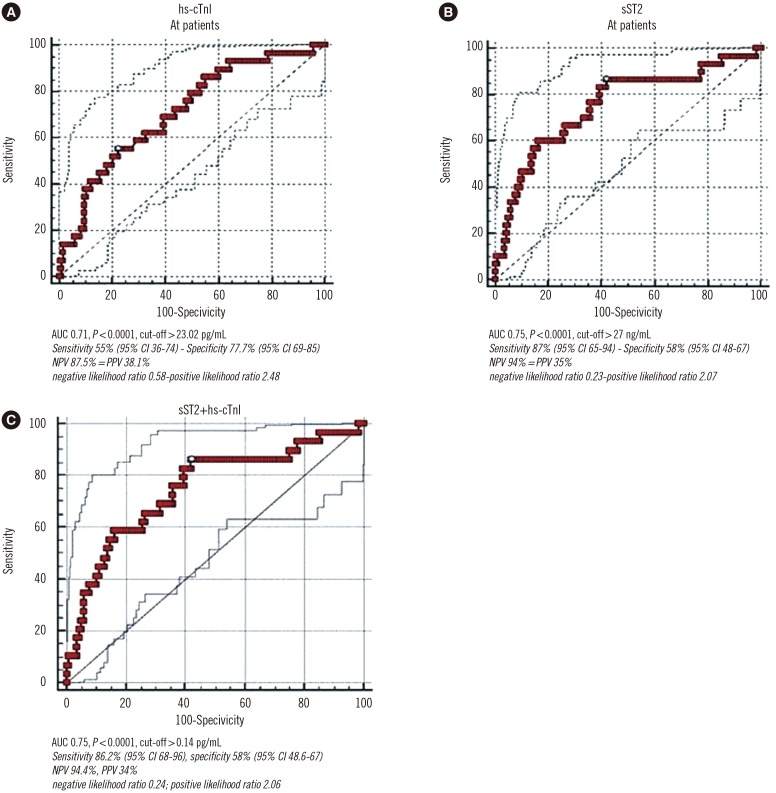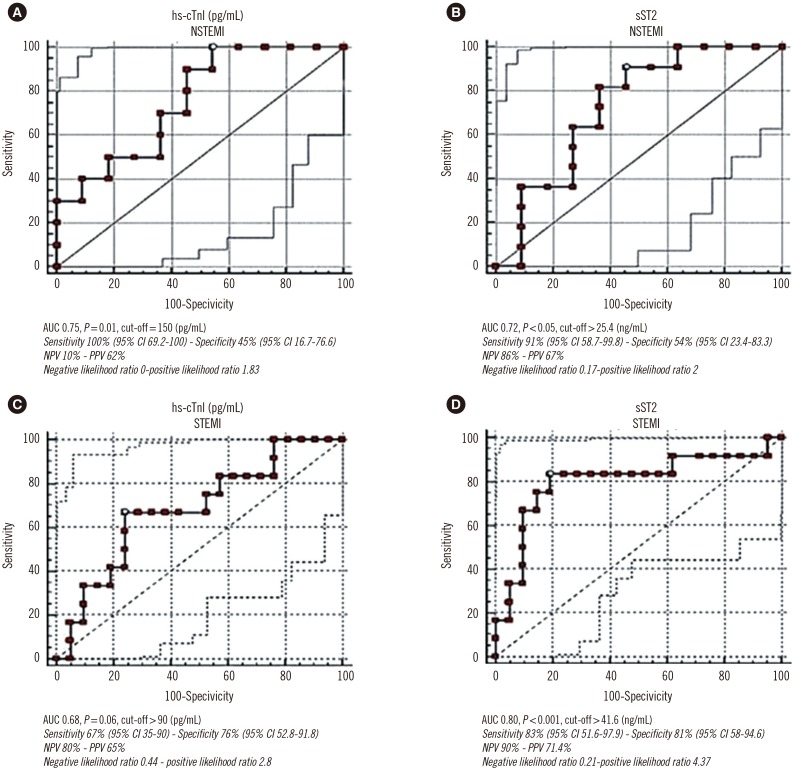Ann Lab Med.
2017 Mar;37(2):137-146. 10.3343/alm.2017.37.2.137.
Comparison Between Soluble ST2 and High-Sensitivity Troponin I in Predicting Short-Term Mortality for Patients Presenting to the Emergency Department With Chest Pain
- Affiliations
-
- 1Department of Medical-Surgery Sciences and Translational Medicine, University Sapienza Rome, Sant' Andrea Hospital, Rome, Italy. salvatore.disomma@uniroma1.it
- 2Clinical and Molecular Medicine Department, Sant' Andrea Hospital, School of Medicine and Psychology, “Sapienza†University, Rome, Italy.
- 3Department of Laboratory Medicine, School of Medicine, Konkuk University, Seoul, Korea.
- KMID: 2373631
- DOI: http://doi.org/10.3343/alm.2017.37.2.137
Abstract
- BACKGROUND
High-sensitivity cardiac troponin I (hs-cTnI) and the soluble isoform of suppression of tumorigenicity 2 (sST2) are useful prognostic biomarkers in acute coronary syndrome (ACS). The aim of this study was to test the short term prognostic value of sST2 compared with hs-cTnI in patients with chest pain.
METHODS
Assays for hs-cTnI and sST2 were performed in 157 patients admitted to the Emergency Department (ED) for chest pain at arrival. In-hospital and 30-day follow-up mortalities were assessed.
RESULTS
The incidence of ACS was 37%; 33 patients were diagnosed with ST elevation myocardial infarction (STEMI), and 25 were diagnosed with non-ST elevation myocardial infarction (NSTEMI). Compared with the no acute coronary syndrome (NO ACS) group, the median level of hs-cTnI was higher in ACS patients: 7.22 (5.24-14) pg/mL vs 68 (15.33-163.50) pg/mL (P<0.0001). In all patients, the sST2 level at arrival showed higher independent predictive power than hs-cTnI (odds ratio [OR] 20.13, P<0.0001 and OR 2.61, P<0.0008, respectively). sST2 at ED arrival showed a greater prognostic value for cardiovascular events in STEMI (area under the curve [AUC] 0.80, P<0.001) than NSTEMI patients (AUC 0.72, P<0.05). Overall, 51% of the STEMI patients with an sST2 value>35 ng/mL at ED arrival died during the 30-day follow-up.
CONCLUSIONS
sST2 has a greater prognostic value for 30-day cardiac mortality after discharge in patients presenting to the ED for chest pain compared with hs-cTnI. In STEMI patients, an sST2 value >35 ng/mL at ED arrival showed the highest predictive power for short-term mortality.
Keyword
MeSH Terms
-
Acute Coronary Syndrome/diagnosis/*mortality
Aged
Area Under Curve
Biomarkers/analysis
Chest Pain
Emergency Service, Hospital
Female
Follow-Up Studies
Humans
Interleukin-1 Receptor-Like 1 Protein/*analysis
Male
Middle Aged
Odds Ratio
Prognosis
ROC Curve
Troponin I/*analysis
Biomarkers
Interleukin-1 Receptor-Like 1 Protein
Troponin I
Figure
Cited by 1 articles
-
Absolute Change in High-Sensitivity Cardiac Troponin I at Three Hours After Presentation is Useful for Diagnosing Acute Myocardial Infarction in the Emergency Department
Jong Won Kim, Hanah Kim, Yeo-Min Yun, Kyeong Ryong Lee, Hyun Joong Kim
Ann Lab Med. 2020;40(6):474-480. doi: 10.3343/alm.2020.40.6.474.
Reference
-
1. Hamm CW, Bassand JP, Agewall S, Bax J, Boersma E, Bueno H, et al. ESC Guidelines for the management of acute coronary syndromes in patients presenting without persistent ST-segment elevation: The task force for the management of acute coronary syndrome (ACS) in patients presenting without persistent ST-segment elevation of the European Society of Cardiology (ESC). Eur Heart J. 2011; 32:2999–3054. PMID: 21873419.2. Fruergaard P, Launbjerg J, Hesse B, Jørgensen F, Petri A, Eiken P, et al. The diagnoses of patients admitted with acute chest pain but without myocardial infarction. Eur Heart J. 1996; 17:1028–1034. PMID: 8809520.3. Amsterdam EA, Wenger NK, Brindis RG, Casey DE Jr, Ganiats TG, Holmes DR Jr, et al. 2014 AHA/ACC Guideline for the management of patients with non-st-elevation acute coronary syndromes: A Report of the American College of Cardiology/American Heart Association Task Force on Practice Guidelines. J Am Coll Cardiol. 2014; 64:e139–e228. PMID: 25260718.4. O'Gara PA, Kushner FG, Ascheim DD, Casey DE, Chung MK, de Lemos JA, et al. 2013 ACCF/AHA guideline for the management of ST-elevation Myocardial Infarction. A report of the American College of Cardiology Foundation/American Heart Association Task Force on Practice Guidelines. J Am Coll Cardiol. 2013; 61:e78–e140. PMID: 23256914.5. Keller T, Zeller T, Peetz D, Tzikas S, Roth A, Czyz E, et al. Sensitive troponin I assay in early diagnosis of acute myocardial infarction. N Engl J Med. 2009; 361:868–877. PMID: 19710485.6. Reiter M, Twerenbold R, Reichlin T, Haaf P, Peter F, Meissner J, et al. Early diagnosis of acute myocardial infarction in the elderly using more sensitive cardiac troponin assays. Eur Heart J. 2011; 32:1379–1389. PMID: 21362702.7. Sherwood MW, Kristin Newby L. High-sensitivity troponin assays: evidence, indications, and reasonable use. J Am Heart Assoc. 2014; 3:e000403. PMID: 24470520.8. Apple FS, Collinson PO. IFCC Task Force on Clinical Applications of Cardiac Biomarkers. Analytical characteristics of high-sensitivity cardiac troponin assays. Clin Chem. 2012; 58:54–61. PMID: 21965555.9. Twerenbold R, Jaffe A, Reichlin T, Reiter M, Mueller C. High-sensitive troponin T measurements: what do we gain and what are the challenges? Eur Heart J. 2012; 33:579–586. PMID: 22267244.10. Jaffe AS, Ravkilde J, Roberts R, Naslund U, Apple FS, Galvani M, et al. It's time for a change to a troponin standard. Circulation. 2000; 102:1216–1220. PMID: 10982533.11. White HD. Pathobiology of troponin elevations: do elevations occur with myocardial ischemia as well as necrosis? J Am Coll Cardiol. 2011; 57:2406–2408. PMID: 21658560.12. Cullen L, Mueller C, Parsonage WA, Wildi K, Greenslade JH, Twerenbold R, et al. Validation of high-sensitivity troponin I in a 2-hour diagnostic strategy to assess 30-day outcomes in emergency department patients with possible acute coronary syndrome. J Am Coll Cardiol. 2013; 62:1242–1249. PMID: 23583250.13. de Lemos JA, Drazner MH, Omland T, Ayers CR, Khera A, Rohatgi A. Association of troponin T detected with a highly sensitive assay and cardiac structure and mortality risk in the general population. JAMA. 2010; 304:2503–2512. PMID: 21139111.14. Ottani F, Galvani M, Nicolini FA, Ferrini D, Pozzati A, Di Pasquale G, et al. Elevated cardiac troponin levels predict the risk of adverse outcome in patients with acute coronary syndromes. Am Heart J. 2000; 140:917–927. PMID: 11099996.15. Aldous SJ, Richards M, Cullen L, Troughton R, Than M. Diagnostic and prognostic utility of early measurement with high-sensitivity troponin T assay in patients presenting with chest pain. CMAJ. 2012; 184:E260–E268. PMID: 22291171.16. Kohli P, Bonaca MP, Kakkar R, Kudinova AY, Scirica BM, Sabatine MS, et al. Role of ST2 in non-ST-elevation acute coronary syndrome in the MERLIN-TIMI 36 trial. Clin Chem. 58:257–266.17. Eggers KM, Armstrong PW, Califf RM, Simoons ML, Venge P, Wallentin L, et al. ST2 and mortality in non-ST-segment elevation acute coronary syndrome. Am Heart J. 2010; 159:788–794. PMID: 20435187.18. Sabatine MS, Morrow DA, Higgins LJ, MacGillivray C, Guo W, Bode C, et al. Complementary roles for biomarkers of biomechanical strain ST2 and N-terminal prohormone B-type natriuretic peptide in patients with ST-elevation myocardial infarction. Circulation. 2008; 117:1936–1944. PMID: 18378613.19. Weinberg EO, Shimpo M, Hurwitz S, Tominaga S, Rouleau JL, Lee RT. Identification of serum soluble ST2 receptor as a novel heart failure biomarker. Circulation. 2003; 107:721–726. PMID: 12578875.20. Turnquist HR, Zhao Z, Rosborough BR, Liu Q, Castellaneta A, Isse K, et al. IL-33 expands suppressive CD11b+ Gr-1(int) and regulatory T cells, including ST2L+ Foxp3+ cells, and mediates regulatory T cell-dependent promotion of cardiac allograft survival. J Immunol. 2011; 187:4598–4610. PMID: 21949025.21. Manzano-Fernández S, Mueller T, Pascual-Figal D, Truong QA, Januzzi JL. Usefulness of soluble concentrations of interleukin family member ST2 as predictor of mortality in patients with acutely decompensated heart failure relative to left ventricular ejection fraction. Am J Cardiol. 2011; 107:259–267. PMID: 21211603.22. Weir RA, Millar AM, Murphy GE, Clements S, Steedman T, Connell JM, et al. Serum soluble ST2: a potential novel mediator in left ventricular and infarct remodeling after acute myocardial infarction. J Am Coll Cardiol. 2010; 55:243–250. PMID: 20117403.23. Miller AM, Purves D, McConnachie A, Asquith DL, Batty GD, Burns H, et al. Soluble ST2 associates with diabetes but not established cardiovascular risk factors: a new inflammatory pathway of relevance to diabetes? PLoS One. 2012; 7:e47830. PMID: 23112853.24. Seki K, Sanada S, Kudinova AY, Steinhauser ML, Handa V, Gannon J, et al. Interleukin-33 prevents apoptosis and improves survival after experimental myocardial infarction through ST2 signalling. Circ Heart Fail. 2009; 2:684–691. PMID: 19919994.25. Richards AM, Di Somma S, Mueller T. ST2 in stable and unstable ischemic heart diseases. Am J Cardiol. 2015; 115(7S):48B–58B.26. Ky B, French B, McCloskey K, Rame JE, McIntosh E, Shahi P, et al. High-sensitivity ST2 for prediction of adverse outcomes in chronic heart failure. Circ Heart Fail. 2011; 4:180–187. PMID: 21178018.27. Erhardt L, Herlitz J, Bossaert L, Halinen M, Keltai M, Koster R, et al. Task force on the management of chest pain. Eur Heart J. 2002; 23:1153–1176. PMID: 12206127.28. Dieplinger B, Januzzi JL Jr, Steinmair M, Gabriel C, Poelz W, Haltmayer M, et al. Analytical and clinical evaluation of a novel high-sensitivity assay for measurement of soluble ST2 in human plasma - the Presage ST2 assay. Clin Chim Acta. 2009; 409:33–40. PMID: 19699192.29. Apple FS, Collinson PO. IFCC Task Force on Clinical Applications of Cardiac Biomarkers. Analytical characteristics of high-sensitivity cardiac troponin assays. Clin Chem. 2012; 58:54–61. PMID: 21965555.30. Kavsak PA, MacRae AR, Yerna MJ, Jaffe AS. Analytic and clinical utility of a next-generation, highly sensitive cardiac troponin I assay for early detection of myocardial injury. Clin Chem. 2009; 55:573–577. PMID: 19168557.31. Brown AM, Wu AH, Clopton P, Robey JL, Hollander JE. ST2 in emergency department chest pain patients with potential acute coronary syndromes. Ann Emerg Med. 2007; 50:153–158. PMID: 17466411.32. Weinberg EO, Shimpo M, De Keulenaer GW, MacGillivray C, Tominaga S, Solomon SD, et al. Expression and regulation of ST2, an interleukin-1 receptor family member, in cardiomyocytes and myocardial infarction. Circulation. 2002; 106:2961–2966. PMID: 12460879.33. McCullough PA, Peacock WF, O'Neil B, de Lemos JA, Lepor NE, Berkowitz R. An evidence-based algorithm for the use of B-type natriuretic testing in acute coronary syndromes. Rev Cardiovasc Med. 2010; 11(S2):S51–S65. PMID: 20700103.34. Dhillon OS, Narayan HK, Khan SQ, Kelly D, Quinn PA, Squire IB, et al. Pre-discharge risk stratification in unselected STEMI: is there a role for ST2 or its natural ligand IL-33 when compared with contemporary risk markers? Int J Cardiol. 2013; 167:2182–2188. PMID: 22835988.35. Aldous SJ, Richards AM, Troughton NR, Than M. ST2 has diagnostic and prognostic utility for all-cause mortality and heart failure in patients presenting to the emergency department with chest pain. J Card Fail. 2012; 18:304–310. PMID: 22464771.36. Demyanets S, Speidl WS, Tentzeris I, Jarai R, Katsaros KM, Farhan S, et al. Soluble ST2 and interleukin-33 levels in coronary artery disease: relation to disease activity and adverse outcome. PLoS One. 2014; 9:e95055. PMID: 24751794.37. Shimpo M, Morrow DA, Weinberg EO, Sabatine MS, Murphy SA, Antman EM, et al. Serum levels of the interleukin-1 receptor family member ST2 predict mortality and clinical outcome in acute myocardial infarction. Circulation. 2004; 109:2186–2190. PMID: 15117853.
- Full Text Links
- Actions
-
Cited
- CITED
-
- Close
- Share
- Similar articles
-
- The usefulness of 0/1-hour algorithm using high-sensitivity cardiac troponin I for evaluating the patients with chest pain in the emergency department
- Is it Necessary to Study both Creatine Kinase MB and Troponin for an Acute Diagnosis of Myocardial Infarction?
- Elevated levels of soluble ST2 but not galectin-3 are associated with increased risk of mortality in hemodialysis patients
- Serum Myoglobin as a Biochemical Marker to Rule Out Acute Myocardial Infarction
- Validation of high-sensitivity troponin I levels for major adverse cardiac events in low risk chest pain patients




